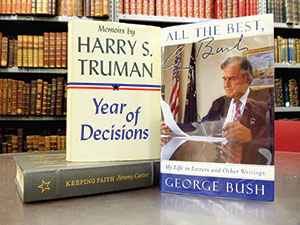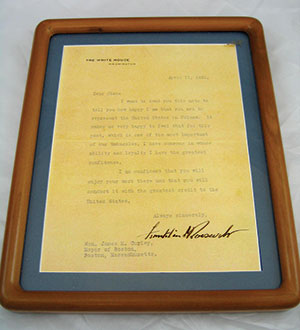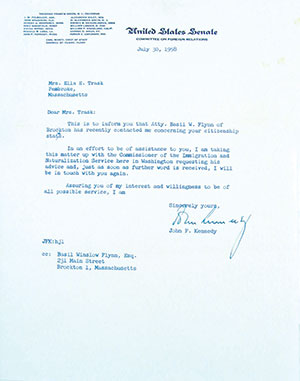
Worthwhile presidential collectibles can include biographical books, signed letters, autographs, and campaign materials.
By Kenneth Gloss
People collect presidential letters to all different degrees, for a variety of reasons. Unlike other areas of collecting, presidential letters and biographies are a defined group, set by the list of which individuals served as president. Having a limited set to choose from can be an advantage in the collecting world because it allows collectors to target their searches and buys.
There is a great deal of material available on presidents as a group and, if you look hard enough, many signed pieces, especially letters, can be found. This is not to say that collecting presidential items is simple or cheap. Indeed, prices can vary tremendously based upon the rarity and content of the material. With letters, it’s the contents and the signature that determine the price. A lengthy letter from President Kennedy talking about the Cuban Missile Crisis or one from George Washington talking about the Revolutionary War is a whole different world from a quick apology note saying the president is unable to attend a social function. If the content is important, letters from Washington and Lincoln can run into the hundreds of thousands or millions of dollars.

Letter signed by FDR.
If you had to make a guess as to which presidential letters are the most rare, few people would say those of William Henry Harrison. He got sick with pneumonia at his inauguration and died a month later. Needless to say, he wrote very few letters in that brief amount of time.
If you are watching your collecting expenses, you can find letters written by presidents before or after their term as president, or other objects besides letters that are signed by them. A lot of presidential letters can be picked up relatively reasonably, for a few hundred dollars. Be careful, however. Latter-day presidents don’t always sign their own letters. From Kennedy onward, presidents began relying on secretaries, signing machines, rubber stamps and the like. Scrutinize them closely and if needed, call in an outsider to verify the signature. In our electronic age, one thing that has stopped is handwriting of virtually everything, particularly correspondence.
One of the great things to study with the old presidential letters and manuscripts is the drafts that preceded the final version. You can get a good idea of the thought processes that went into the composition, and the personality of the writer, in different versions of a letter. Nowadays, you only see the final copy because most letters are composed on a computer. In addition, the bulk of the letter is machine printed, with only the signature and maybe a postscript being handwritten by the president.
Autographs and signed materials are very popular with collectors, particularly those who have a passion for their subject, because they seem to bring you closer to the person who signed it. I’ve held letters written by Washington, Roosevelt, and Kennedy. When you touch that document, running your finger over the place where the president’s pen rested, it’s amazing to realize that person actually touched the same piece of paper and held their pen to it. It is part of the allure of collecting signed pieces. You are attached, tactically and vicariously, to whom ever wrote it.
A lot of people who collect presidential autographs and other presidential memorabilia are very interested in American history and the history of the presidency. One of the best ways to study a presidential term is through both autobiographies and biographies, because each lends its own perspective. Some of these books may be signed, a practice you will find more common with modern presidents. The classic presidential biography is George Washington’s. Parson Mason Locke Weems was a traveling book salesman who wrote four editions of Washington’s life story when he realized sales had started to slow down. For the fifth edition, he made up the story about the cherry tree and it sold like crazy, with that story sticking to this day. Weem’s The Life of Washington is one of the most rare books to look for.

Letter signed by JFK.
Some collectors focus on one president. Some people collect only campaign biographies that tend to be much, much different from later historical biographies, the latter offering a more honest and well-rounded view. One of the best-written biographies is the story of Franklin Pierce. Written by Nathaniel Hawthorne, it earned the author a job as a customs official afterwards.
While not impossible, it can be quite difficult to collect every one of the presidential biographies. For some presidents, there aren’t many versions still in existence. The most expensive biographies, however, are relatively cheap compared to collecting presidential signatures. This is a great way of collecting presidential material without having to spend a lot of money.
In addition to signatures and books there are also many ephemeral things, like campaign buttons, which you can collect to complete your presidential collection. Overall, material on presidents abounds and offers a great place for a beginning collector to start amassing a group of interesting items.
Ken Gloss is the owner of the Brattle Book Shop in Boston, the oldest antiquarian bookstore in the United States. The Gloss family has owned the Brattle Book Shop for 58 years. Ken has been seen on PBS’ “Antiques Road Show.” Further information about the show, Ken’s free and open talks and getting books appraised can be found at www.brattlebookshop.com or by call 1-800-447-9595 or visiting the shop at 9 West Street in downtown Boston.















Reader Comments